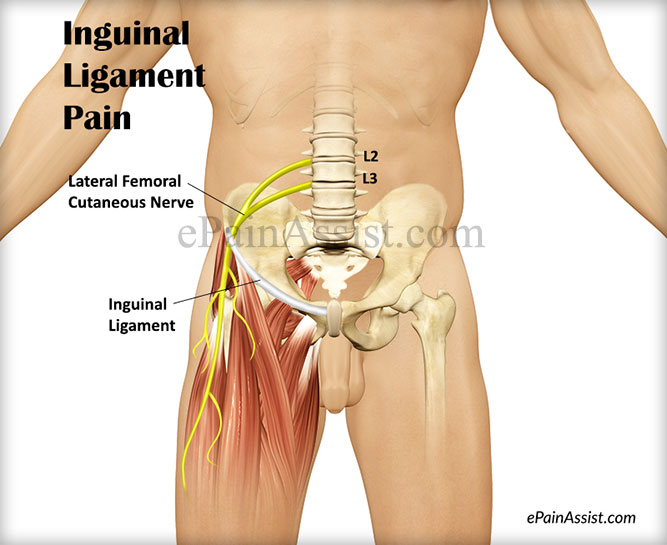What is Inguinal Ligament and What is its Function?
The Inguinal Ligament is a constricted band of thick fibrous connective tissues which are present in the pelvic region of the body.1 These tissues arise from the external oblique and course through across the groin and attaches to the front part of the iliac spine. The inguinal ligament forms the floor of the inguinal canal and provides support to the passage of structures through the canal.
The inguinal ligament supports the muscles which course inferiorly to the fibers of the ligament, including the iliopsoas muscles.2 It also supports the femoral vein, artery, and nerve along with other blood vessels and nerves of the lower extremities as they course through the pelvic area. This support is important to maintain the flexibility of the hip and supply nutrients and blood supply to the lower extremities.

What is Inguinal Ligament Pain?
The Inguinal Ligament helps in preventing the intestines from projecting out from the groin. It also supports the external oblique muscles in the abdomen. Inguinal Ligament Pain is normally seen in athletes who run and sprint a lot and put these ligaments at risk of straining and tearing. A person suffering from Inguinal Ligament Sprain will experience unusual popping feelings in the pelvic region proceeded by severe pain. There will be palpable tenderness in the groin and inner thigh. The patient will also find it difficult to raise and lift the knee or bring the legs close together.
What Can Cause Inguinal Ligament Pain?
As stated, the main cause of Inguinal Ligament Pain is a sprain of that ligament. Inguinal Ligament Sprains can be classified into three categories.
Grade I Inguinal Ligament Sprain: This is a mild form of sprain and causes no symptoms except for some mild inguinal ligament pain in the groin but does not affect movement of the person.
Grade II Inguinal Ligament Sprain: This is a moderate form of sprain and results in moderate inguinal ligament pain, swelling, and bruising. The patient may find it difficult to jump, run, or do activities that put pressure on the thighs due to this sprain.
Grade III Inguinal Ligament Sprain: This is the most severe form of Inguinal Ligament Sprain and is caused due to severe injury to the ligaments. In such sprains, the patient suffers from severe incapacitating inguinal ligament pain. Patients may also experience muscle spasms, swelling, and bruising along with loss of function in the lower extremities till the inguinal ligament sprain completely resolves.
What is the Treatment for Inguinal Ligament Pain?
In case if Inguinal Ligament Pain is caused due to a hernia then this will have to be treated surgically. The surgery will involve grafting the sprained inguinal ligament and support it with mesh material to prevent further herniation.
The first 48 hours after an Inguinal Ligament Sprain is extremely important with regard to the success of treatment and expediting the healing process. Immediately after the injury or experience of inguinal ligament pain, the patient may apply ice packs to the groin area to decrease pain and calm down the inflammation. NSAIDs can also be taken to relieve inguinal ligament pain. In cases of Grade I Inguinal Ligament Sprains, walking exercises may also be recommended to decrease stiffness and facilitate healing.
For Grade II Inguinal Ligament Sprains, moist heat can be used. The rehabilitation may be done with abduction, adduction, straight leg, hip rotation exercises. Using compression wraps can also be of value in improving range of motion hasten healing process.
For Grade III Inguinal Ligament Sprains surgery may be recommended to repair severe tears and when the above recommended measures are of not help.
Physical Therapy for Inguinal Ligament Pain
Physical therapy is an important aspect for treating Inguinal Ligament Sprain. This is done in three levels.
Level 1 Physical Therapy for Inguinal Ligament Pain: In this regimen, light exercise like using a stationary bicycle with seat as low as possible and resistance set extremely low is recommended. This should be done as tolerated. Static groin stretches should be performed at least five times daily with each stretch being held for about 30 seconds.
Level 2 Physical Therapy for Inguinal Ligament Pain: Static groin stretches should be started and a strengthening program should be undertaken. Examples of groin strengthening exercises are straight leg raises in which you bring your leg toward the midline of the body and abduction where you pull your leg away from the midline of the body. Hip flexion, hip internal and external rotation can also be useful. These exercises need to be performed every alternate day.
Level 3 Physical Therapy for Inguinal Ligament Pain: This level of therapy starts approximately a week after the injury causing inguinal ligament pain. The exercises mentioned before need to be continued and may be progressed with more reps. Functional activities may begin as tolerated. When all the strength in the groin has returned and there is no pain with performing exercises then a gradual return to activity may be tried after Inguinal Ligament Sprain.
